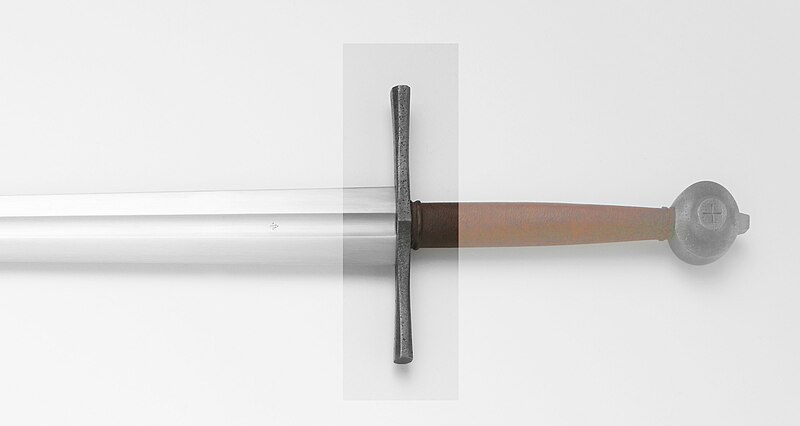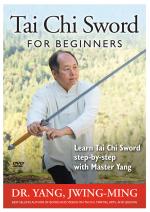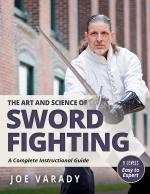Short swords are generally more accessible than long swords as they are easier to carry and deploy quickly. They are also more maneuverable since they are small enough to be used effectively in close quarters as well as wieldy enough to feint, faking your opponent out by suddenly changing directions mid-stroke. The disadvantage of the short sword is usually its shorter range; however, remember that “short sword” refers to the length of the handle, not the blade, so there are some exceptions to this rule. The great equalizer when it comes to single-handed swords is that they can be used with a shield or second weapon, allowing you to check an opponent’s longer weapon in order to close into striking range, but dual wielding is the topic for another book.
Training Equipment: The Sword
Before you can start training, you are going to need a sword. There is a plethora of swords available on the market and choosing the right one is not merely a matter of personal preference. It is important that you know how to choose a sword that fits your body size and feels good in your hand. It must also be of appropriate construction for the type of training you will be doing.
Materials
Do NOT buy a sharp sword! At least, not yet. A sharp sword can be as dangerous as a loaded gun and should never be used for any kind of partner work. Even at Live Steel Fight Academy, although we occasionally test cut with live blades, we NEVER sparred with sharp steel. Buying a sharp sword would be like playing airsoft or paintball with real guns. Keep your sharp swords reserved for test cutting. In fact, you don’t even need to buy a metal sword at all.
Wooden Swords
Since wooden swords are far cheaper and usually safer than their metal counterparts, every culture that has employed the sword has used wooden substitutes in training. In Japan, samurai practiced with the bokken, while in England soldiers trained with wooden swords called wasters. Wooden swords maintain the weight and heft of a real sword but are far less likely to inflict serious injury. They are also durable enough to withstand the wear and tear of hard training without needing to be replaced very often. They do have to be checked regularly, however, for cracks and splinters. Minor damage can usually be fixed with sandpaper and wood glue.
Synthetic Swords
Swords made from polypropylene or other plastics, commonly referred to as “synthetics,” are a modern-day contribution to sword training. Keep in mind, though, that you get what you pay for. Cheap swords are usually either too heavy and stiff or too light and flexible. Well-made synthetics, on the other hand, are designed to be as close to real swords in weight, balance, and size as possible so that they help develop proper form and technique in solo practice, partner drills, and sparring. The disadvantage of synthetics is that they do not simulate real blades when pressed together, an action referred to as a “bind.” Sharp metal blades tend to catch, unlike synthetics that slip when pressed against each other, making it difficult to execute many techniques with realism. Like wooden swords, synthetics are generally less expensive than metal swords, as well as much safer to train and fight. Unlike wood, synthetic swords are extremely durable and do not crack or splinter. Since they can be used for a long time without needing to be replaced, they make a cost-effective investment. Overall, synthetic swords are a great option for regular training.
This is not to say that wooden or synthetic swords are not dangerous. While they are generally regarded as safer than their metal counterparts, wooden or synthetic swords can still hit hard enough to cause serious injury, especially if you are not wearing protective equipment suitable to the intensity of the activity. A waster or bokken, swung with intent and no control, can snap a femur. When thrusting, flexible plastic or modern spring steel swords are safer than a wooden sword because they are designed to bend.
Padded Swords
Foam padded swords are good for light sparring with minimal protective gear. However, they generally lack the weight and heft of a real sword and therefore do not make very good trainers. Not only do they lack the feel of the genuine article, but most padded swords are not designed to hold up to intensive training against anything but another padded weapon. Their weaker, often hollow, plastic cores can’t stand up to hard collisions against denser and heavier wooden or synthetic swords. The one advantage of foam swords is that they tend to stick together in the bind like sharp blades would, making them good for developing skills for that particular instance.
Blunt Steel Blades
Training with blunt steel blades is very exciting and most closely replicates using a live blade. However, blunts are costly in comparison to wood and synthetic trainers. They also require more substantial protective gear to be used safely, especially in sparring. Nicks or bends in a blunt sword require maintenance and, even when fixed, can create weak spots where the blade may be subject to future breakage under stress.
Unsharpened training swords made of light, soft metals such as aluminum, are intended for solo demonstration only and will not hold up under any sort of contact drill. Likewise, “fantasy” swords, and other swords created for display purposes, lack the structural integrity required for safe training and likewise should not be used. And, let me say it one more time, just to be clear: DO NOT use a sharp sword, even for solo work. Sharp swords, sometimes referred to as “sharps,” require the utmost attentiveness and should only be used for test cut- ting under very controlled conditions (see Appendix 3 at the end of this book).
A Precautionary Tale
In 1989, I was a twenty-year-old college student and a member of a fraternity at Gettys- burg College. I was also the senior student of the karate club, and as such I was in charge of ordering supplies. One day, my big brother, Smitty, was in my room and started thumbing through the catalogue. His eyes lit up when he saw the swords. “Buy me a sword!” he said excitedly.
“No way,” I responded, “you’ll cut yourself, or worse, someone else.”
But that wasn’t the end of it. Over the next few days, Smitty kept bugging me about ordering a sword. “If you won’t order it for me, I’ll just call the number and buy it myself,” he sulked.
Eventually, to avoid him being mad at me, and against my better judgement, I added a sword to the next order.
When the shipment finally arrived, Smitty rushed into my room. “Where is it?” he demanded.
I reluctantly handed him a long, slender cardboard box. “I’m still not sure I should be giving you this.”
“Whatever, worry-wort,” Smitty taunted as he unceremoniously tore open the box and removed the three-foot katana that lay within. Grasping the handle in one hand and the shiny black scabbard in the other, he drew the blade half way out of its sheath. “Wicked cool!” he uttered, turning the blade slightly and watching in awe as the light reflected off the oiled steel.
“Please be careful,” I warned, “this isn’t a toy.”
“Yeah, yeah,” he chided me, snapping the blade back into the scabbard, and added, “I’m not stupid, you know.” He turned on his heel, shut the door behind him, and was gone.
It wasn’t more than a few minutes later that my door burst open once again. This time it wasn’t Smitty, it was his roommate. His eyes were huge, and he spoke way too fast. “Smitty just stabbed himself! We’re taking him to the hospital!” he shouted, turned, and was gone, leaving me staring at an empty doorway.
As soon as I realized he wasn’t kidding, I rushed out after Smitty’s roommate, catching up with him as Smitty was being loaded into a car in front of the fraternity house. Smitty, though on his feet, was clamping a bunched-up t-shirt to his left thigh. Blood was leaking out from underneath, running down his thigh, and soaking his blue jeans red. I was in shock as I asked him, “What the heck happened?”
Smitty didn’t answer. In fact, he wouldn’t even look at me as he got into the car. His roommate was more than happy to fill me in. “Smitty gave us a little demonstration with his new sword,” he explained excitedly, “but, when he went to put it away, he missed the sheathy-thingy completely and stabbed himself right in the leg!” He could barely contain his laughter.
Smitty shut the door and rolled down the window. He looked at me and finally spoke. “It went right in,” he said, his voice filled with amazement, “like a hot knife through butter.” Then he suddenly snapped back to his old self, “When I get back, I don’t want to hear any ‘I told you so’s,’ okay?!”
By the time Smitty returned from the hospital a few hours later, with seven stitches closing the wound in his thigh, I had secured the katana and placed it back in its box. As requested, we didn’t talk about it. By dinner that evening, however, the entire fraternity had heard the story, and the brothers all had a good laugh at Smitty’s expense. In the end, I gave Smitty back his money and kept the sword for myself, taking it home with me on the next break. A fraternity house was no place for a live blade!
Length
Short swords come in a great variety of shapes and sizes. The specific sword type does not matter as much as its capabilities. Long, thin blades make effective thrusting weapons while short, thick blades are more suited for cutting and chopping at close range. While there are advantages and disadvantages to all swords, the most versatile sword is a medium-sized, general-use sword that is good for both cutting and thrusting.
A typical single-handed sword has an overall length between thirty inches to thirty-six inches from tip to pommel. To properly measure a sword for you, stand normally with the sword in your dominant hand and let it hang loosely at your side. The tip should come close to the floor, but not touch the ground. This length is a good for a beginner, as a longer sword may be more cumbersome to wield, and a shorter sword may not have the required reach.
Once you have gained competence with the basic techniques using a medium-length sword, you can try fencing with a longer sword. The Italian fencing master Capo Ferro recommended a long rapier that, when the tip is resting on the floor, has quillons level with the user’s navel, resulting in a sword with an overall length somewhere between thirty-nine inches and forty-five inches. He thought, and I quite agree, that this length provided the optimal balance of speed and reach, allowing the swordsman to cut and thrust from a safe distance. However, it takes time to develop the strength and coordination required to wield such a sword effectively. It is far easier to learn with a more manageable, medium-length sword. George Silver recommended a sword that was short enough that, if you were to grab your opponent with your off hand, you could still easily stab him with your sword.
Other than that, what appeals to you? Do you lean more toward Eastern swords or Western? Your sword can have a single or double edge. It can also be straight or curved. Keep in mind that, as I mentioned in regard to longer swords, those with a very dramatic curve have special characteristics that require a certain degree of experience to be used effectively, and, as such, should be avoided during the early stages of training.
After you have mastered the basics of sword fighting, you may choose to specialize in one type of sword or another. Always remember that the sword is just a tool, a means to an accomplish a goal. Therefore, the most effective sword is the one that is best suited to the situation. In the end, though, it can be said that victory is determined as much by the skills of the swordsmen as the types of swords they wield or armor they wear.
The above is an excerpt from The Art and Science of Sword Fighting: A Comprehensive Instruction Guide by Joe Varady, Publication Date July 2024, YMAA Publication Center, ISBN: 9781594399879 .







